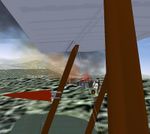Dogfighting tips
 |
| Bombable |
|---|
| a FlightGear addon |
|
| Related |
The Bombable Flightgear add-on was developed with the idea that in a realistic flight simulator environment, the ideas about aerial combat developed by the best skilled pilots of all eras--such as those by World War I aces, below--would naturally develop as a result of the aircrafts' innate capabilities and limitations.
Following these historical rules and guidelines does indeed work in dogfighting with Bombable in FlightGear--whether with AI aircraft or with other real pilots over multiplayer.
Dicta Boelcke
Rules for Aerial Combat from the WWI era by the first great German flying ace of the First World War, Oswald Boelcke
1.Try to secure the upper hand before attacking. If possible, keep the sun behind you.
2.Always continue with an attack you have begun.
3.Only fire at close range, and then only when the opponent is properly in your sights.
4.You should always try to keep your eye on your opponent, and never let yourself be deceived by ruses.
5.In any type of attack, it is essential to assail your opponent from behind.
6.If your opponent dives on you, do not try to get around his attack, but fly to meet it.
7. When over the enemy's lines, never forget your own line of retreat.
8. Tip for Squadrons: In principle, it is better to attack in groups of four or six. Avoid two aircraft attacking the same opponent.
Edward Mannock's rules
Edward Mannock, the first British WWI flying ace, wrote this set of rules:
- Pilots must dive to attack with zest, and must hold their fire until they
get within one hundred yards (90 m) of their target.
- Achieve surprise by approaching from the East. (From the German side of the
front.)
- Utilise the sun's glare and clouds to achieve surprise.
- Pilots must keep physically fit by exercise and the moderate use of
stimulants.
- Pilots must sight their guns and practise as much as possible as targets are
normally fleeting.
- Pilots must practise spotting machines in the air and recognising them at
long range, and every aeroplane is to be treated as an enemy until it is certain it is not.
- Pilots must learn where the enemy's blind spots are. Scouts must be attacked
from above and two-seaters from beneath their tails.
- Pilots must practise quick turns, as this manoeuvre is more used than any
other in a fight.
- Pilot must practise judging distances in the air as these are very
deceptive. Decoys must be guarded against — a single enemy is often a decoy — therefore the air above should be searched before attacking.
- If the day is sunny, machines should be turned with as little bank as
possible, otherwise the sun glistening on the wings will give away their presence at a long range.
- Pilots must keep turning in a dog fight and never fly straight except when
firing.
- Pilots must never, under any circumstances, dive away from an enemy, as he
gives his opponent a non-deflection shot — bullets are faster than aeroplanes.
- Pilots must keep their eye on their watches during patrols, and on the
direction and strength of the wind.
Adolph Malan's "TEN OF MY RULES FOR AIR FIGHTING"
- Wait until you see the whites of his eyes. Fire short bursts of one to two
seconds only when your sights are definitely "ON".
- Whilst shooting think of nothing else, brace the whole of your body: have
both hands on the stick: concentrate on your ring sight.
- Always keep a sharp lookout. "Keep your finger out".
- Height gives you the initiative.
- Always turn and face the attack.
- Make your decisions promptly. It is better to act quickly even though your
tactics are not the best.
- Never fly straight and level for more than 30 seconds in the combat area.
When diving to attack always leave a proportion of your formation above to act as a top guard.
- INITIATIVE, AGGRESSION, AIR DISCIPLINE, and TEAM WORK are words that MEAN
something in Air Fighting.
- Go in quickly - Punch hard - Get out!
